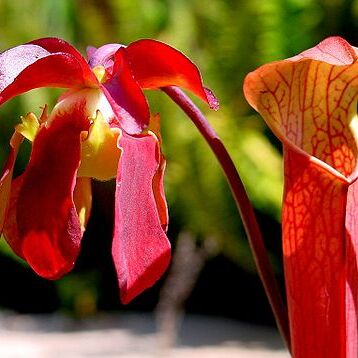Herbs, clump-or mat-forming, not stoloniferous; rhizomes horizontal or vertical. Pitchers marcescent or persistent, erect to ascending or decumbent to sprawling, usually monomorphic (sometimes trimorphic in S. alabamensis, summer forms differing from spring forms), not twisted, green, yellow-green, reddish, or purplish, tubiform, gradually tapering from base to orifice (urceolate in S. purpurea, S. rosea), firm or soft, exterior surface glabrous or finely pubescent; orifice round to oval, not facing ground, opening terminally except in S. psittacina, gaping or partly to completely covered by hood; hood arising abaxially from rim of orifice, erect to recurved adaxially, ovate to orbiculate or reniform, flattened or dome-shaped (subglobose in S. psittacina), not lobed, proximal margins cordate to attenuate, often forming distinct neck, apex apiculate (not apiculate in S. purpurea, S. rosea). Phyllodia absent or persistent, produced in mid summer, green, oblanciform or falcate. Scapes 1 (sometimes 2 in S. alabamensis, S. jonesii, S. rubra), longer or shorter than pitcher; bracts 3, usually appressed or adjacent to sepals, clasping, spreading or arched, ovate-triangular or ovate-oblong, apex obtuse to rounded. Flowers usually odoriferous (fragrant as in roses or ill-scented as in cat urine), rarely odorless (S. minor); sepals persistent, broadly ovate-triangular or ovate, margins entire, apex obtuse or rounded; petals deciduous, only slightly touching basally, pendulous between lobes of style disc, pandurate, the larger distal portions obovate, orbiculate, ovate, or elliptic, margins entire or erose, apex rounded; stamens 50-100, barely coherent at base in 10-17 vague fascicles, falling separately; filaments slightly variable in length; anthers dorsifixed, not versatile; ovary globose to conic, shallowly 5-lobed, apex rounded; style distally expanded into broad umbrellalike disc with midribs (arms) extending into 5 evenly spaced, reflexed, distally notched lobes; stigmas simple, filiform, (1 mm), at base of style-disc notches, (inflexed). Capsules globose to ovoid, coarsely tuberculate, basipetally dehiscent (acropetally dehiscent in S. leucophylla). Seeds 400-1000, irregularly clavate to reniform-obovate, laterally keeled, tuberculate to reticulate-tuberculate. x = 13.
More
Perennial herbs, with rhizomes. Leaves clumped; carnivorous leaves: tubular-shaped ('pitcher'), marcescent or persistent, with operculum ('hood') over the entrance ('mouth'), the rim on top of the pitcher tube (peristome) a rolled lip, secretes nectar and scents to attract prey; non-carnivorous leaves (phyllodia) may be produced in colder periods, when carnivorous pitcher leaves sometimes start to wither at the end of autumn with the onset of colder weather. Flowers solitary, facing downwards, on a long stem often placing them above the pitcher traps; sepals 5, superintended by 3 bracts; petals 5, yellow or reddish; style umbrella-like, 5-pointed, stigmas located at the tips. Capsule globose to ovoid, with maturity turning nearly vertically, basipetally or (in S. leucophylla) acropetally dehiscent, with numerous small seeds.
Sep 5, broad and spreading; pet 5, incurved, soon deciduous; stamens many; ovary large, subglobose; style slender at base, above extended into 5 rays connected by tissue and forming a 5-angled or-lobed, umbrella-shaped body with the minute stigmas beneath it at the angles; fls solitary on scapes; lvs bearing a broad or narrow wing along the adaxial side and prolonged beyond the pitcher on the abaxial side into a broad hood; x=13. 8, e. N. Amer.

